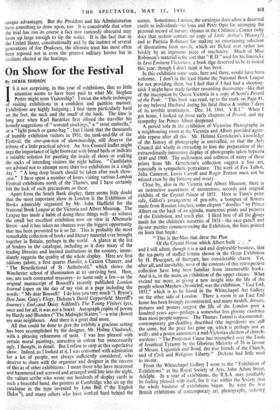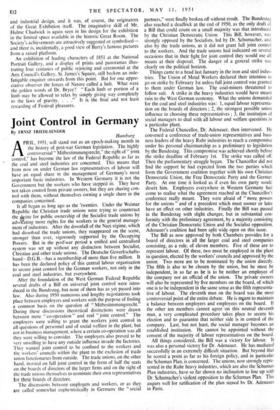On Show for the Festival
li) DEREK HUDSON IS it not surprising, in this year of exhibitions, that so little attention seems to have been paid to what Mr. Stephen Potter might term Visitorship? I mean the whole technique of visiting exhibitions in a confident and painless manner. Exhibitions are highly fatiguing ; I find them particularly hard on the feet. the neck and the small of the back. The time is long past when Karl Baedeker first offered the traveller his homely suggestions of " worsted stockings," a "stout umbrella," or a" light pouch or game-bag " ; but I think that the thousands of humble exhibition visitors in 1951, the rank-and-file of the Festival, the sine-qua-non of showmanship, still deserve the tribute of a little practical advice. An Arts Council leaflet might urge the importance of light footwear with broad heels or indicate a suitable solution for painting the inside of shoes or soaking the socks of intending visitors the night before. "Candidates are advised not to attempt more than two exhibitions in a single day." "A. long deep breath should be taken after each show- case." I have spent a number of hours visiting various London Festival exhibitions north of the Thames, and I have certainly felt the lack of such precautions as these.
Apart from the South Bank display, there seems little doubt that the most important show in London is the Exhibition of Books admirably organised by Mr. John Hadfield for the National Book League at the Victoria and Albert Museum. The League has made a habit of doing these things well—as witness the small but excellent exhibition now on view in Albemarle Street—and it has taken no chances over the biggest opportunity that has been presented to it so far. This is probably the most remarkable collection of books and literary material ever brought together in Britain, perhaps in the world. A glance at the list of lenders in the catalogue, including as it does many of the leading libraries and learned institutions in the country, imme- diately suggests the quality of the whole display. Here are first editions galore, a first quarto Hamlet, a Caxton Chaucer, and "The Benedictional of St. Aethelwold," which shows the Winchester school of illumination at its surviving best. Here, too, are such contrasted treasures—to name only a few—as the original manuscript of Boswell's recently published London Journal (open on the day of my visit at a page including the words : "My dear Boswell! I do love you very much "), Byron's Don Juan, Gray's Elegy, Dickens's David Copperfield, Sheriffs Journey's Endmind Daisy Ashford's The Young Visiters (yes, once and for all, it was not a hoax). Autograph copies of poems by Hardy and Blunden (" The Midnight Skaters "—a wise choice) are near neighbours. And there is a great deal more. All that could be done to give the exhibits a gracious setting has been accomplished by the designer, Mr. Hulme Chadwick, with a pleasing refinement of taste. I was less pleased with certain mural paintings, attractive in colour but unnecessarily ugly. I thought, in detail. But I refuse to carp at this superlative show. Indeed, as I looked at it. I was consumed with admiration for a lot of people, not always sufficiently considered, who deserve to share with the organiser and designer in the success of this as of other exhibitions: I mean those who have measured and hammered and screwed and arranged until late into the night, the valiant scribe who wrote out hundreds of display cards in such a beautiful hand, the printers at Cambridge who set up the catalogue in the type invented by John Bell (" the English Didot"), and many others who have worked hard behind the scenes. Sometimes, I notice, the catalogue does allow a deserved credit to individuals—to Ions and Peter Opie for arranging the pictorial record of nursery rhymes in the Children's Corner (why does that section contain no copy of Little Arthur's History?) and to Patricia Robinson for making an entertaining selection of illustrations from novels, which are flicked over rather too briskly by an ingenious piece of machinery. Much of Miss Robinson's material is the sort that" R.D." used for his limericks in Less Eminent Victorians., a book dip deserved to be re-issued this year, though I don't think it has been.
In this exhibition some seats, here and there, would have been.
welcome. I don't in the least blame the National Book League for not providing them, hut I feel that if I had had a shooting- stick I might have made further rewarding discoveries—like that of the inscription by Queen Victoria in a copy of Scott's Peveril of the Peak: "This book was read, up to the mark on Page 81, to my beloved Husband during his fatal illness & within 3 days of its terrible termination. Dec. 14. 1861. V.R.I." When I got home, I looked up those early chapters of Peveril, and my sympathy for Prince Albert deepened. A period sofa in the exhibition of Victorian Photography in a neighbouring room at the Victoria and Albert provided agree- able repose after all this. Mr. Helmut Gernsheim's knowledge of the history of photography is unrivalled, so that the Arts Council did wisely in entrusting to him the preparation of this extraordinarily interesting display of photographs taken betwees 1840 and 1900. The mellowness and softness of many of these prints from Mr. Gernshcim's collection suggest a lost art, especially in sympathetic portraiture. The work of Fox Talbot. Julia Cameron, Lewis Carroll and Roger Fenton must not be missed even by the footsore and weary.
Close by, also in the Victoria and Albert Museum, there is an instructive assortment of mementoes. records and original exhibits of the Crystal Palace of 1851. Here is Tann's prize safe, Gillott's arrangement of pen-nibs, a bouquet of flowers made from Russian isinglass, some elegant " doodles " by Prince. Albert on the back of an agenda, numerous prints and pictures of the Exhibition, and much else. I liked best of all the kings made for the children's nurseries of 1851—the race-gam and jig-saw puzzles commemorating the Exhibition, the lines printed on linen that begin: "This is the Man that drew the Plan Of the Crystal House which Albert built . . ." and I will admit, though it is a sad and deplorable business, that the tea-party of stuffed kittens shown in the Great Exhibition by H. Ploucquet, of Stuttgart, has considerable charm. Yet, after all, and inevitably, most of the contents of this retrospective collection have long been familiar from innumerable books. And it is. in the main, an exhibition of the upper classes. What excited me more, as giving a new insight into the life of the people whom Mayhew chronicled, was the exhibition." East End, 1851," which is to be found in the Whitechapel Art Gallery on the other side of London. There a room in an East End home has been lovingly reconstructed, and many models, dresses, pictures and posters suggest the life of the London poor a hundred years ago—perhaps a somewhat less gloomy existence than most people suppose. The Thames Tunnel is documented: contemporary gin-distilling described (the ingredients are still the same, but the price has gone up. which is perhaps just as well) ; and a poster announces a mid-Victorian election of church- wardens: "The Protestant Cause has triumphed over the Tools of Jesuitical Tyranny by the Glorious Majority of 76 in favour of Messrs. Liquorish and Bond, the true friends of the Church, and of Civil and Religious Liberty." Dickens had little need to invent.
From the Whitechapel Gallery I went to the "Exhibition of Exhibitions" at the Royal Society of Arts, John Adam Street. Adelphi. In a year of exhibitions. the R.S.A. may justifiably be feeling pleased with itself, for it was within the Society that the whole business of exhibitions began. Its were the first British exhibitions of contemporary art, photography, industry: and industrial design, and it was, of course, the originators of the Great Exhibition itself. The imaginative skill of Mr. .Hulme Chadwick is again seen in his design for the exhibition in the limited space available in the historic Great Room. The Society's achievements are attractively suggested or symbolised— and there is, incidentally, a good view of Barry's famous pictures from a raised platform.
An exhibition of leading characters of 1851 at the National Portrait Gallery, and a display of prints and panoramas illus- trating four centuries of public rejoicing and ceremonial at the .Arts Council's Gallery, St. James's Square, still beckon an inde- fatigable enquiter onwards from this point. But for one appre- ciative observer the forces of Nature called a halt. What were the golden words of Dr. Bryce? "Each limb or portion of a limb may be allowed to relax by simply giving way completely to the laws of gravity. . . ." It is the final and not least rewarding of Festival pleasures.



































 Previous page
Previous page